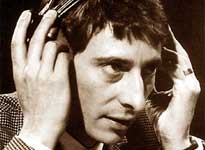|
LUC FERRARI 
Chansons pour le corps (1988-94)
Elise Caron, voice
Carol Mundinger, Sylvan Frydman, clarinets
Christine Lagniel, percussion
Michel Maurer, piano
Michel Musseau, synthesizer
Et si tout entière maintenant… (1986-87)
Symphonic tale for actress, tapes & orchestra
Anne Sèe, voice
Nouvel Orchestre Philharmonique
Yves Prin, conductor
Mode 81
Luc Ferrari (1929 - 2005) was one of the most distinct and original voices to emerge from France in the second part of the twentieth century, a significant exponent of musique concrete and a composer who used computer technology meaningfully to express musical and visual ideas successfully.
This CD consists of two substantial works that use prerecorded samples with live instrumental sounds. Chansons pour le corps (1988 – 1994) is a delightful contemporary “song cycle” where real and synthetic voices alternate with instrumental interludes. The music is often repetitive and has frequent tonal/ neo-tonal influences. This is partly because the composer is using well articulated and widely understood musical objects ranging from late nineteenth / early twentieth century as points of reference. Nevertheless, this is also very meditative music in parts, highly expressive and intensely colorful. Ferrari makes the most of the small ensemble of clarinet, percussion (mainly vibraphone) piano and synthesizer - this combination or small variations of it have subsequently featured heavily in many works by IRCAM composers.
The text for Chansons pour le corps is by Colette Fellous. The process of collaboration between the writer and the composer is very intriguing, as in many ways the composer ‘pre-directed’ the writer. The composer first interviewed random young women who were asked questions about different parts of their body. Those recorded interviews were then developed in the studio so as to create an artificial “speaking choir” that supports the singer. It is from that part that the writer wrote the texts.
The formal concept of the work consists of four songs that deal with different body parts and a final fifth song that serves more as a recapitulation. The singer (Elise Caron) is superb throughout and she is very successful in conveying and projecting the different sensations and images that the composer is trying to capture.
Et si tout entiére maintenant (1986-1987) works particularly very well after Chansons pour le corps, even though the concept and instrumentation are very different. This symphonic collage of “experiences” had its origins on an Arctic voyage of a Swedish icebreaker. Ferrari had detailed recordings made, which he then edited at his studio. The process of collaboration with the writer is very similar to the artists’ previous collaboration. The instrumental recordings are by Nouvel Orchestre Philharmonique, conducted by Yves Prin. The sound of the orchestra is always assuring and well balanced; all explosions of sound, colour and gesture are particularly well controlled.
The singer (narrator rather) this time is Anne Sée who does a superb job in giving each word its full (and at times multiple) meaning, thus skillfully contributing greatly towards a convincing realization of the composer’s intended atmosphere.
Here again, the live music is structured more as Interludes, its linear development usually coming to an abrupt end by the pure electronic parts. At first hearing, the work sounds bizarre but one can always feel that music and text merge together very naturally. The transitions between clear story telling, anecdotes and visual imagery portrayed by the real conversations of travelers have very clear music representations. Sometimes the material sounds extremely original, whereas at others extremely classical, almost reminiscent of the seminal works of early twentieth century. The overall result, typical of the compos, has highly ambiguous meaning oscillating between reality and fiction.
Traditional processes, almost in imitation of well defined classical music objects, combined with repetitive processes, good taste and the composer’s ability to know exactly when to move on, make these two works highly artistic and this CD a wonderful compilation, definitely worth purchasing.
Evis Sammoutis
|



